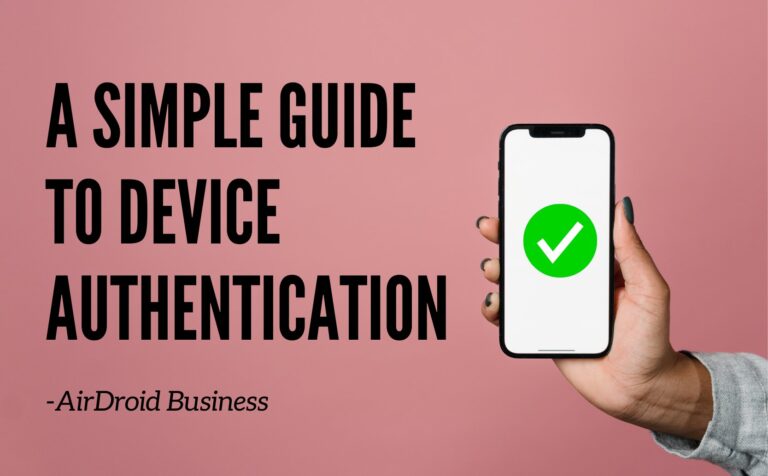A Simple Guide to Device and Endpoint Authentication

Whether you're a tech expert or a casual user, if you own smart devices, device authentication is part of your experience. This can take the form of passwords, biometrics, multi-factor authentication, and more, all sharing the common goal of safeguarding important data from unauthorized access.
For devices owned by companies dealing with sensitive data, the stakes of improper device authentication are even higher. This is precisely the focus of our discussion today.
In this guide, we'll delve into the fundamentals of device authentication, exploring various methods and addressing potential challenges. By the end, you'll gain practical insights to establish a secure authentication plan.
1 What is Device Authentication?
Let’s start from the basics.
Device authentication is the process of verifying legitimacy of a device before granting it access to a network or system. This way, only legitimate device can connect and interact with sensitive data or resources.
To put it simply, it is like having a bouncer at the entrance of an exclusive party. You need to show your ID to get into the party. Likewise, each device gets a special ID card with a secret code or key that proves it is legitimate.
As you can probably imagine, device authentication is important for keeping the network secure, especially when dealing with remote users. Without this verification, any random gadget could waltz into the network, causing all sorts of trouble like unauthorized access, data breaches, and more security problems.
2How Device Authentication Works in Action?
The specific mechanisms and protocols used for device authentication can vary, but the general principles remain consistent.
Let’s take a look at how device authentication typically works:
Identification
• When a device attempts to connect to a network or service, it initiates the authentication process by sending an identification request.
• The device provides some form of unique identifier, such as a MAC address, device serial number,
or a digital certificate.
Authentication credentials
• The network or service checks the provided identifier against a list of authorized devices.
• In addition to the identifier, the device may need to present authentication credentials, such as a username and password, a digital certificate, or a token.
Encryption
• Communication during the authentication process is often encrypted to protect the exchange of sensitive information.
• Encryption ensures that even if the authentication data is intercepted, it remains unreadable without the proper decryption keys.
Access Control
• Once the device is successfully authenticated, access control mechanisms determine the level of access the device is granted.
• Access control policies specify what resources the authenticated device is allowed to use or access.
3 4 Endpoint Authentication Examples
Endpoint authentication is not only about matching the credentials of devices but also the credentials of users.
Here, we list some common methods used by devices to authenticate their users:
Passwords and PINs
Probably the most well-known example in device authentication, Passwords and Personal Identification Numbers (PINs) serve as foundational elements in authentication, also known as password-based or knowledge-based authentication.
By crafting a secret code composed of characters, numbers, or symbols, individuals establish unique credentials to validate their identity and gain access to devices securely.
Biometric Authentication
Biometric authentication uses your unique physical or behavioral characteristics, like fingerprints or facial recognition, to verify your identity. It offers high security as these traits are hard to replicate.
And the best part? You don't need to worry about remembering passwords or PINs.
Two-factor Authentication (2FA)
2FA is a user identity authentication process that requires the user to know (first factor) and possess certain information, such as a token, smart card, or mobile device (second factor).
For example, when accessing sensitive financial data on a company's server, you must enter username and password on the login portal. To enhance security, a second factor is required, such as a one-time password (OTP) generated by an authenticator app on your mobile device. This extra step reduces the risk of unauthorized access, even if someone has the user's password.
Multi-factor Authentication (MFA)
Multi-factor authentication (MFA) goes beyond 2FA by adding extra factors to what the user already knows and possesses. These can include things like biometric data or specific behavior patterns.
MFA is commonly used in high-security environments to protect sensitive data. Even if one factor is compromised, multiple layers of security prevent unauthorized access.
4 Bumps in the Road for Endpoint Authentication
It's clear that even these device authentication methods can have their weak spots. The authentication methods outlined above are, without a doubt, indispensable for safeguarding security.
However, when companies try to put them in place, they may still face some tricky challenges.
• Weak passwords
Passwords often represent the weakest link in the authentication process. Employees in enterprises may opt for weak passwords or reuse the same password across multiple accounts, exposing them to risks like brute-force attacks or credential stuffing.
• Password Reuse
Users might reuse passwords across multiple services or platforms, increasing the risk of compromise if one account is breached.
• Credential Theft
Attackers may use various techniques, such as phishing or malware, to steal user credentials and gain unauthorized access.
• Inadequate Multi-Factor Authentication (MFA)
If multi-factor authentication is not properly implemented or not used at all, it leaves the system vulnerable to attacks that rely solely on compromised passwords.
• Outdated Software and Firmware
Endpoints running outdated software or firmware may have known vulnerabilities that attackers can exploit to bypass authentication mechanisms.
• Unauthorized Devices
Devices that are not properly authenticated or are not supposed to be on the network might gain access, leading to potential security breaches.
• Phishing and Social Engineering
Attackers may manipulate individuals into divulging sensitive information or performing actions that compromise the security of the endpoints.
5 Simple Tips for a Secure Device Authentication Strategy
Despite the challenges that you might encounter, here are some tips to implement a secure device authentication strategy:
1. Use strong passwords and enforce regular updates. Companies can implement password policies, requiring special characters, specific lengths, and regular password changes to enhance security.
2. Keep software and firmware updated. Make it a routine to regularly update your software and firmware to address vulnerabilities. This can help devices receive the latest security enhancements at all times. Streamline this process with automated tools for quick and efficient updates.
3. Educate your staff on security practices. Conduct regular training sessions to educate staff on creating strong passwords, recognizing phishing attacks, and reporting suspicious activities. Building awareness reinforces good security habits.
4. Utilize remote wipe features. In the event of a lost or stolen device, leverage remote wipe features to erase data remotely and protect sensitive information.
5. Implement centralized device management. A centralized device management system provides a comprehensive view of all devices connected to your network, simplifying monitoring and management of device authentication.
6. Carry out continuous monitoring and alerts. Establish a system that continuously monitors device authentication activities. Get alerts for anything suspicious, so you can act fast in case of a security breach or unauthorized access attempt.
6 How AirDroid Business MDM Can Help You Out?
If you find these best practices a bit overwhelming (and they certainly can be), it's time to consider adopting a Mobile Device Management tool to simplify the process.
Take AirDroid Business, for example; it comes with features that can help you implement and maintain your device authentication strategy:

🔺Security Policy:
▪ Enforce lock screen password policies.
▪ Set specific actions for non-compliant behavior on a device.
▪ Restrict installation of unknown resource apps.
▪ Remotely wipe all sensitive data on a lost or stolen device.
🔺Centralized Device Management:
▪ Manage devices by grouping them based on business purposes.
▪ Create predefined device provisioning, including device-specific restrictions and mandatory app installations.
▪ Once a device is registered, these provisions will be automatically applied.
🔺AirDroid Business's Application Management Service (AMS):
▪ Configure, deploy, and keep your devices' apps updated.
▪ Set up automatic updates for apps.
🔺Monitor, Alerts, and Workflow:
▪ AirDroid Business MDM provides continuous monitoring.
▪ Receive alerts when abnormal events are detected.
▪ Execute automated workflows to address issues promptly.
7 Wrapping up
As devices employ different methods to authenticate users, such as passwords, PINs, fingerprints, and additional verification steps (like receiving a code on your phone), there is a possibility of things going awry in the process.
This is where the MDM (Mobile Device Management) solution, AirDroid Business, proves useful, assisting you in effectively managing and securing all company-owned endpoints.
Find out how AirDroid Business can make your device checks way more secure!






Leave a Reply.